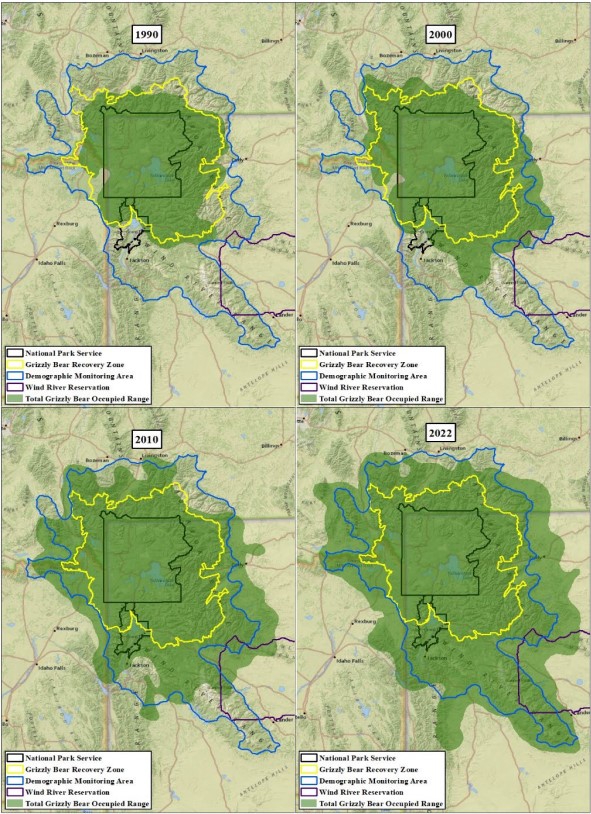Grizzly Delisting Decision May Take Until Next Summer, Feds Say
Wyoming calls the Fish and Wildlife Service’s delay “appalling”
- Published In: Other News & Features
- Last Updated: Sep 12, 2023

A grizzly bear sow and her cubs forage along Obsidian Creek in Yellowstone National Park in June. Bears within the park would be unaffected by the State of Wyoming’s efforts to delist the region’s grizzlies. (Courtesy photo from Jacob W. Frank of the National Park Service)
By CJ Baker
Special to the Wyoming Truth
The U.S. Fish and Wildlife Service said it needs another year to decide whether it will remove the Greater Yellowstone Ecosystem’s grizzly bears from the list of threatened species. The State of Wyoming, however, said the federal agency should only get another month — and apologize for taking too long.
Continuing a decades-long battle over the species, Gov. Mark Gordon has been pushing Fish and Wildlife to turn grizzly management over to the states; his administration filed a petition to delist the region’s bruins in January 2022. By law, the Fish and Wildlife Service was required to make a final decision within 12 months, but that deadline passed with only a commitment to study the issue further.
In May, the state sued Secretary of the Interior Deb Haaland and Fish and Wildlife Service Director Martha Williams, seeking to force them to make a decision within 30 days. Although it continues to analyze Wyoming’s petition, the agency called such a deadline “patently unreasonable.”

With limited staff and a slew of obligations related to grizzly bears, Fish and Wildlife officials contend they need more time to make a “legally and scientifically sound decision.” They’re asking U.S. District Court Judge Alan Johnson to give the agency until July 31, 2024.
“Almost every decision involving grizzlies is met with a lawsuit, and Wyoming has failed to provide any rationale why [Fish and Wildlife Service] should impatiently run headlong into a maelstrom without giving the decision the appropriate care and deliberation it deserves,” a group of attorneys from the U.S. Department of Justice’s Environment & Natural Resources Division wrote in a Friday filing.
But Gordon’s administration, represented by the Wyoming Attorney General’s Office, has expressed deep skepticism and frustration with the delays.
“The fact that the State had to sue Secretary Haaland and Director Williams to force them to comply with the [Endangered Species Act] is appalling. And their stated reason for their inaction — too much work to do and not enough resources to do it — is preposterous,” Special Assistant Attorney General Jay Jerde wrote in a filing last month, asserting that the officials are deliberately flouting the law.
“… A mandatory deadline in a federal statute is like a prairie hail storm – the agency cannot run from it, cannot hide from it, and cannot make it go away,” Jerde wrote in his opening. “Yet Secretary Haaland and Director Williams apparently believe the mandatory deadlines in the Endangered Species Act do not apply to them.”
Although conceding it isn’t a viable option, Jerde said the court should order Haaland and Williams “to publicly apologize for deliberately disregarding federal law.” He said they’ve undermined the effectiveness of the Endangered Species Act and “done immeasurable damage to the public’s trust in them to be accountable, law-abiding government officials.”
In Friday’s response, the service countered that Wyoming’s argument was “not an honest assessment of [Fish and Wildlife’s] efforts and frankly counterproductive to grizzly bear recovery.”
Regardless of how this dispute turns out, “Wyoming and [Fish and Wildlife Service] will need to productively work together for a long time … and hyperbole does not aid those discussions,” the DOJ attorneys wrote.
A long and complicated history
The federal officials suggested the hail storm analogy was more apropos for the animosity grizzlies faced in Wyoming before being listed as an “threatened” species, as “The bears could not run from it, hide from it, or make it go away.”

An estimated 50,000 grizzly bears roamed the western U.S. prior to European settlement, but government-sponsored eradication programs and no hunting limits drove the population down to only about 750 animals by 1974, according to Fish and Wildlife. In the Greater Yellowstone Ecosystem, as few as 136 grizzlies remained.
However, since receiving federal protections in 1975, the species has made a substantial recovery: There are now at least 965 bears roaming the core habitat of the Greater Yellowstone Ecosystem, according to federal estimates.
Since 2005, the Fish and Wildlife Service has attempted to remove federal protections for the region’s grizzlies, deeming the population recovered. But those efforts have faced opposition from environmental and tribal groups, particularly over concerns that Wyoming, Montana and Idaho plan to allow limited hunting of the predators.
Federal judges in Montana struck down delisting attempts in 2008 and 2017. The most recent rejection was generally affirmed by the Ninth Circuit Court of Appeals in 2020, with the appellate court finding two primary faults with the proposed delisting.
First, the court ruled that Fish and Wildlife needs “concrete, enforceable mechanisms in place to ensure the long-term genetic health of the Yellowstone grizzly”— such as by getting Wyoming, Montana and Idaho to commit to bringing in bears from other regions when necessary.
Second, the appellate judges said the states need to commit to “recalibration” — that is, to adjust the number of bears that can be hunted or otherwise killed by humans when the federal government changes the way it estimates the number of bears; the lower court expressed concern that the states might kill more bears if a new counting method results in a higher population estimate.
Wyoming said both of those issues have been addressed, but the Fish and Wildlife Service contends more work is needed. The agency also said it has a lot of other work to do.
Competing priorities
The service is simultaneously working on a petition from the State of Montana that seeks to delist the grizzlies that roam the Northern Continental Divide Ecosystem in the northern part of that state. Meanwhile, Idaho has threatened to sue over the rejection of its petition to delist all grizzlies in the lower 48.
Additionally, Fish and Wildlife is addressing a court order related to the potential of reintroducing grizzlies to the Bitterroot Mountains in east-central Idaho, and it’s assessing the possibility of reintroducing grizzlies to the North Cascades Ecosystem in Washington.
“This is hardly foot dragging,” the DOJ wrote, rebutting an accusation from Wyoming’s brief.
Jerde suggested that Fish and Wildlife draw from its 8,000-person workforce to expedite the process and help the seven employees overseeing grizzly bear recovery efforts in the West. However, the agency said there’s a limited number of staff with the needed expertise and knowledge — and they can’t just bump Wyoming to the front of the line.
“After all, the other states and entities are just as litigious when it comes to grizzlies,” the DOJ wrote.
Fish and Wildlife is asking for Wyoming’s suit to be dismissed, alleging the state failed to show it has been harmed by the delay and has standing to bring the case. Wyoming will have the opportunity to file a reply.
Even if Judge Johnson dismisses the suit, the service said it is committed to completing its “12-month finding” by no later than July 2024. By that point, it will have been 30 months since Wyoming filed its petition.













